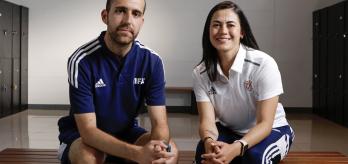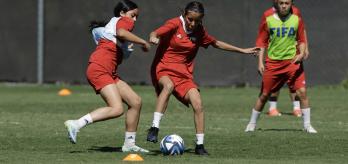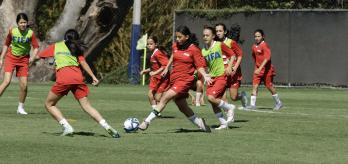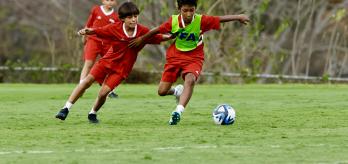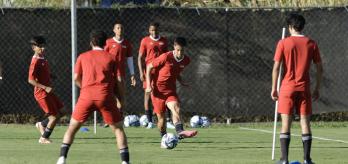Players undergo a series of exercises designed to sharpen both their individual and team skills when facing opponents with the ball. Aggressive actions, such as driving toward an opponent, help cultivate the right mindset, while technical skills—like close control, quick footwork, and recognizing when an opponent is off balance—enhance the players' chances of successfully beating opponents in 1v1 situations to create scoring opportunities for themselves and teammates.
In this session, FIFA Talent Coach Claudio García and Costa Rican Football Association (FCRF) Talent Coach Manfred Schumann deliver exercises focused on 1v1 actions. The session begins with a warm-up and introduces approaches to 1v1 scenarios. The first exercise focuses on 1v1 and 2v2 situations, where players must beat an opponent to score. A 4v4 small-sided game follows, allowing players to apply their 1v1 actions in a team structure, leading into a 7v7 plus 6 game where players can use additional teammates to create 2v1 situations. The session concludes with a 10v10 game plus goalkeepers, providing players with the chance to apply their 1v1 skills in a real-game context.
Session overview
Key coaching points
-
By adopting an aggressive and positive approach, players will put themselves in the right mindset to succeed in 1v1s.
-
Close control, quick footwork, explosive movements and the ability to identify available space are required to beat an opponent.
-
Quick combinations followed by assertive movements can help to break defensive lines.
-
Players should seek to create space to dribble into using feints, including dummy passes and deceptive body movements.
Part 1: 1v1 activation
The warm-up focuses on the player level and gives participants a chance to activate their 1v1 skills. The drill replicates scenarios in which a player must be aggressive and positive to take advantage of situations when the opposition are on the back foot.
-
Mark out three 15m x 10m exercise areas.
-
Position two mini-goals at both ends of each exercise area.
-
Split the players into teams of 3 or 4.
-
Position a team to the right-hand side of each end of the exercise area .
-
Each player must have a ball.
-
The first blue-team player moves forward and carries the ball at speed towards the mini-goal facing them.
-
As soon as the blue-team player takes a shot on goal, the first player from the orange team enters the pitch and carries the ball at speed towards the mini-goal facing them.
-
The blue-team player must immediately switch to a defensive role.
-
The orange-team player has to try to score in the mini-goal.
-
Every time a shot is made or attempted, the next player from the opposite team enters the exercise area and the attacker becomes the defender.
-
An aggressive approach and positive mindset are required to beat an opponent in a 1v1.
-
Close control, quick footwork and deceptive body movements can help players to throw defenders off balance.
-
Players should focus on explosive movements and be ready to push past an opponent once they are off balance.
Part 2: Varied attack v. defence drills
This part continues to focus on the player scale but also introduces unit-level aspects in the form of 2v2s and 2v2 plus 1s. The emphasis is on players’ individual skills, especially dribbling, in the 1v1s, whilst players must also link up and coordinate with team-mates in the 2v2s.
-
Mark out three 10m x 10m exercise areas and four 10m x 5m exercise areas.
-
Position a mini-goal at both ends of each small exercise area.
-
Position two mini-goals at both ends of each large exercise area.
-
Divide the group of players so that a 2v2 drill can be played in each large exercise area and a 1v1 drill can be played in each small exercise area.
-
If there are spare players, play a 2v2 plus 1 in one or more of the larger exercise areas, with a neutral player who plays with the in-possession team.
-
In the small exercise areas, players must try to take on their opponent and score in the mini-goal.
-
Players swap roles immediately after a goal has been scored or there has been a turnover of possession.
-
In the larger areas, the team in possession must combine and score in either of the mini-goals facing them.
-
The team must swap roles if a goal has been scored or there has been a turnover of possession.
-
The players should move between the small and large exercise areas so that they all have the opportunity to participate in 1v1s, 2v2s and 2v2 plus 1s.
-
Close control, quick footwork, feints and explosive movements are key factors in 1v1 scenarios.
-
In 2v2 or 3v2 scenarios, players must decide whether a pass or a take-on is the best way to beat their opponent.
-
Players must continuously create space off the ball and keep moving to fashion openings for passes or into which team-mates can carry the ball.
-
Players should be fast and aggressive.
Part 3: 4v4s
In this small-sided game, players work on unit-level aspects, such as using structured passing and 1v1s to break the opposition’s defensive lines. Players must also use their individual skills, such as quick footwork, passing and off-the-ball movement.
-
Mark out two 30m x 15m exercise areas.
-
Position two mini-goals at either end of each exercise area.
-
Split the group into four teams of 4.
-
Play a 4v4 drill in each exercise area.
-
The coach introduces the ball.
-
The in-possession team must try to play through the opposition and score in one of the mini-goals.
-
The opposing team must try to win the ball and then go on to score.
-
1 player for the in-possession team must operate inside the opposition’s shape and try to get behind them.
-
Attacking players should constantly create passing angles by dropping into pockets of space and moving beyond the press.
-
Attacking players should maintain an organised structure in which they occupy certain spaces to build and play through.
-
Take-ons should be used to disrupt the opposition’s defensive organisation and create space for team-mates.
-
Players should be quick and pass forward as soon as possible.
-
Players operating in the opposition’s shape must time their movements to drop and receive the ball or run in behind their opponents.
-
Encourage players to be creative by allowing them to play without the offside rule.
Part 4: : 7v7 plus 6
The focus of this game is on team-level aspects, such as playing quick combinations through the centre and in the channels to break down the opposition’s defensive organisation. The team must focus on pass-and-move actions and be ready to take on players to disrupt the opposition’s structure.
-
Use one half of a full-size pitch.
-
Position a full-size goal at each end.
-
Place a goalkeeper in each goal.
-
Mark out 10m-wide channels on either side of the pitch.
-
Split the players into two teams of 7 and one team of 6.
-
The teams of 7 contest a 7v7 game.
-
The team of 6 is neutral. Place a player in each of the wide channels, two in the centre of the pitch and one player to the side of each of the goals.
-
The ball starts with one of the goalkeepers.
-
The team in possession must build up play and try to score in the opposite goal.
-
They must use the 6 neutral players to help them to play through the opposition.
-
The two neutral players who are positioned in the wide channels must remain there.
-
If the opposition win the ball, they must try to score, with the help of the neutral players.
-
If the ball goes out of play for a corner or a goal is scored, play starts again with the goalkeeper of the attacking team. The teams rotate or switch roles after a set period of time.
-
Attacking players should be aggressive on the ball and look for quick combinations to unbalance the opposition.
-
Attacking players should seek to stretch defenders by using the wide players and then attacking the space behind.
-
If the opportunity arises, players should aim to take out pressing lines by dribbling past their opponents.
-
Whenever a route towards goal is shut off, attacking players should look to make quick switches and changes of direction.
-
Players should avoid building up through congested zones and forcing passes into team-mates, which can lead to turnovers in dangerous areas.
-
Attacking players should use the neutral players positioned next to the goals to provide directness and mix it up.
-
Players should be encouraged to use the full width of the exercise area to avoid congested zones.





